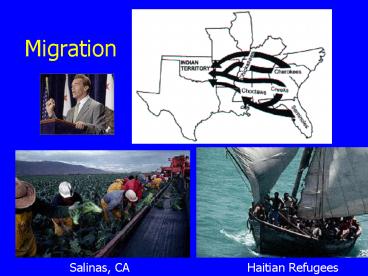Migration - PowerPoint PPT Presentation
1 / 23
Title:
Migration
Description:
Migration Haitian Refugees Salinas, CA Why do people migrate? Push Factors Pull Factors World Migration Routes Since 1700 U.S. Immigration Prior to 1840, 90% of U.S ... – PowerPoint PPT presentation
Number of Views:67
Avg rating:3.0/5.0
Title: Migration
1
Migration
Haitian Refugees
Salinas, CA
2
Why do people migrate?
- Push Factors
- Pull Factors
Emigration and immigration Change in
residence. Relative to origin and destination.
Major International Migration Patterns, Early
1990s
Slide graphic courtesy of Dr. Jean-Paul Rodrigue,
Hofstra University
3
World Migration Routes Since 1700
European
African (slaves)
Indian
Chinese
Japanese
Majority of population descended from immigrants
Slide graphic courtesy of Dr. Jean-Paul Rodrigue,
Hofstra University
4
U.S. Immigration
- Prior to 1840, 90 of U.S.immigration was from
Britain - Two Big Waves
- 1840 - 1930 W. and N. European transitioning to
Southern and Eastern European by 1910 - Irish (potato famine in 1840s) and Germans
- During 1900s Italians, Russians, Austria-Hungary
(Czech, Poland, Romania, etc.) - 1950 - Today Asians and Latin Americans
declining Europeans - Asians China, India 1980s -1990s Phillipines,
Vietnam, and South Korea - Latin America Mexico, Dom. Rep., El Salvador,
Cuba, Haiti - 1986 Immigration Reform and Control Act admitted
former illegals in 1990, 1991.
Ellis Island National Monument
5
U.S. Migration
- Prior to 1840, 90 of U.S.immigration was from
Britain - Three trends
- Destinations of U.S. Immigrants - ethnic
neighborhoods often result of chain migration - Mexicans California, Texas, Illinois, New York
- Caribbean Florida or New York
- Chinese and Indians New York California
- Other Asians California
- Armenians ????
Ellis Island National Monument
6
- U.S. Immigration Policies
- 1882, Bars Asian immigration for ten years
(extended) - 1921, Quota Act - country by country quotas
- 1924 National Origins Act - country by country
quotas - 1965, Immigration Act - quotas for countries
replaced, in 1968, with hemisphere quotas of 170,
000 for East and 120,000 for West - 1978, Immigration Act - global quota of 290, 000
- 1980, Refugee Act - quotas do not apply to those
seeking political asylum - 1986, Immigration Reform and Control Act admitted
large numbers of former illegals. - 1990, Immigration Act raised global quotas to
roughly 675,000 - 1995, visas issued Preferentially
- 480,000 - to relatives of people here
- 140,000 - to those with special skills and
education - 55,000 - to diversity candidates (i.e., mostly
not from Latin Amer. or Asia) - Current Total 675,000
7
(No Transcript)
8
US Population by Race and Ethnicity, 1990-2050
Slide graphic courtesy of Dr. Jean-Paul Rodrigue,
Hofstra University
9
Top 10 Countries of Origin for US Legal
Immigrants, 1998
Slide graphic courtesy of Dr. Jean-Paul Rodrigue,
Hofstra University
10
Illegal Aliens in the United States by Country of
Origin, 1996 (in 1,000s)
Slide graphic courtesy of Dr. Jean-Paul Rodrigue,
Hofstra University
11
Population Pyramid of Native and Foreign Born
Population, United States, 2000 (in )
Foreign Born
Native
Male
Female
Female
Male
Age
Slide graphic courtesy of Dr. Jean-Paul Rodrigue,
Hofstra University
12
Types of Migration
- Internal Migration
- Within one country.
- Crossing domestic jurisdictional boundaries.
- Movements between states or provinces.
- Little government control.
- Factors
- Employment-based.
- Retirement-based.
- Education-based.
- Civil conflicts (internally displaced population).
Slide courtesy of Dr. Jean-Paul Rodrigue, Hofstra
University
13
Migration by Major Metropolitan Areas in the
United States, 1990-98 (in 1,000s)
Slide graphic courtesy of Dr. Jean-Paul Rodrigue,
Hofstra University
14
The Ten Fastest-Growing Metropolitan Areas,
19902000Source U.S. Census Bureau, Census
2000 1990 Census. Web www.census.gov
15
Types of Migration
- Circular migration
- A type of temporary migration.
- Associated with agricultural work.
- The migrant follows the harvest of various crops,
moving from one place to another each time. - Very common in the US Southwest (Mexican farm
workers) and in Western Europe (Eastern European
farm workers).
16
Types of Migration
- Voluntary migration
- The migrant makes the decision to move.
- Most migration is voluntary.
- Forced Migration
- Involuntary migration in which the mover has no
role in the decision-making process. - Slavery.
- About 11 million African slaves were brought to
the Americas between 1519 and 1867. - In 1860, there were close to 4 million slaves in
the United States. - Refugees.
- Military conscription.
- Children of migrants.
- Situations of divorce or separation.
Slide graphic courtesy of Dr. Jean-Paul Rodrigue,
Hofstra University
17
Key Term Forced Migration
18
Forced Migration
The Trail of Tears, 1838
19
Slaves Reaching British North America, 1601-1867
(in 1,000s)
Slide graphic courtesy of Dr. Jean-Paul Rodrigue,
Hofstra University
20
Interregional Migrations
- U.S. population has been moving Westward and
Southward - Gold Rush (1849) and Donner Party just the most
dramatic examples of hardship. - Wells, Pumps, Aqueducts, Mosquito Control and Air
Conditioning have allowed this move which
otherwise would be impossible. - Loss of Industrial Jobs in east compliments
increase in Sunbelt service sector (biotech,
communications).
21
Voluntary African-American Migrations
- Blacks moved to Industrial Belt (i.e., Chicago,
New York, Detroit) and Los Angeles during World
Wars (labor shortages).
22
Intraregional Migrations in U.S.
- U.S. population has been moving out of the city
centers to the suburbs suburbanization and
counterurbanization
- Developed Countries suburbanization
- automobiles and roads
- American Dream
- better services
- counterurbanization
- idyllic settings
- cost of land for retirement
- slow pace, yet high tech connections to services
and markets
U.S. intraregional migration during 1990s.
23
Intraregional Migrations in LDCs
- Populations in the less developed world are
rushing to cities in search of work and income.
- Urbanization
- migration from rural areas
- lack of jobs in countryside
- lack of services in cities
- Tokyo, Los Angeles, and New York only MDC cities
on top 10 list
Lagos, Nigeria
Mumbai, India
Mexico City, Mexico































